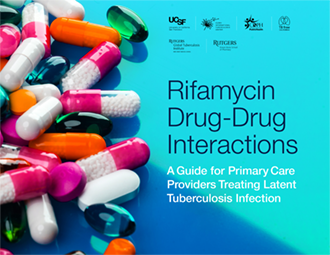
Rifamycin Drug-Drug Interactions: A Guide for Primary Care Providers Treating Latent Tuberculosis Infection was created through a collaboration of the State of California Department of Public Health, Tuberculosis Control Branch (CDPH), the Rutgers Ernest Mario School of Pharmacy (EMSOP), the Rutgers Global Tuberculosis Institute (GTBI), and the Curry International Tuberculosis Center (CITC).
This guide summarizes drug-drug interactions (DDI) between drugs commonly used in primary care and rifamycins, in the context of treatment of latent tuberculosis infection (LTBI). Note that in the 2020 Guidelines for the Treatment of LTBI from the Centers for Disease Control and Prevention, rifampin and rifapentine are each included in preferred regimens for LTBI. Rifabutin is not included in a preferred regimen for LTBI and is included here only for reference. Many rifamycin DDIs can be managed with clinical monitoring or dosage modifications. In this table form DDI guide, drugs are grouped by class; medical providers can access clinical recommendations for each drug and compare drug options within the same drug class.
For treatment of (active) tuberculosis disease, or if you have additional questions regarding LTBI therapy or DDI, please consult an infectious diseases specialist, your local public health department, or your regional TB Center of Excellence.
More information on LTBI treatment options can be found here: https://www.cdc.gov/tb/topic/treatment/ltbi.htm.
Additional resources for providers are also available at: https://www.cdc.gov/tb/publications/ltbi/ltbiresources.htm.
Release Date: December 2022
View/Download
Documents
Rifamycin Drug-Drug Interactions 2022